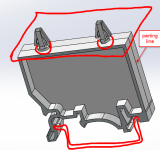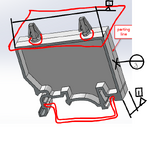Great observation on DIN rail - probably should have been the first part of the original description.
This is a great example of back-driveable requirements. The clip onto the DIN rail, by itself, will restrain 3 rotations and 2 translations, but in a way that the standard doesn't address.
The springy tab will, in conjunction with the opposite tab grip the rail and provide capture of 1 rotation with an axis parallel to the length of the rail. This is the rotation used to install the item to the rail.
The width of the slots will provide significant capture of 1 rotation perpendicular to that axis, but not total capture.
The depth of the slots will provide notable capture of 1 rotation side-to-side on the rail, but it won't provide significant capture.
If someone grabs that item, while it is snapped onto the rail, they will be able to twist it relative to the rail and rock it side to side because the flexible tab will allow that to happen.
This is what I mean by backdrivable. Even though the slots in the mounting tabs can provide alignment, they cannot force alignment in two of the rotations; the user is able to backdrive the orientation of the major features relative to the mating part by forcing the nominal datum features out of alignment with the mating part.
Devices on DIN rails are typically packed like sardines on the rail, so the major influence on the latter two rotations is the major faces; all that has to happen to allow that packing is the slots being sufficiently large, width and depth, and the tab being springy, as to allow enough rotation without breaking the tabs.
I would likely make the main face the primary datum feature (one translation, two rotations) and then use the bottom facing (in the illustration) co-planar surfaces of the two slots as secondary (one translation, one rotation) and then use the inside face of the slot on fixed tab that mates with the DIN rail as the tertiary (one translation).
The slots the DIN rail contacts would be given a profile tolerance with the main face as their primary datum feature.



